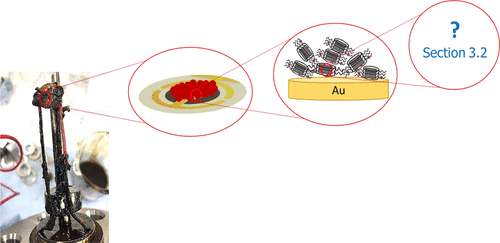当前位置:
X-MOL 学术
›
Ind. Eng. Chem. Res.
›
论文详情
Our official English website, www.x-mol.net, welcomes your
feedback! (Note: you will need to create a separate account there.)
Exploration of the Difference in Molecular Structure of n-C7 and CO2 Induced Asphaltenes
Industrial & Engineering Chemistry Research ( IF 3.8 ) Pub Date : 2018-06-20 , DOI: 10.1021/acs.iecr.8b01634
Edris Joonaki , Jim Buckman , Rod Burgass , Bahman Tohidi
Industrial & Engineering Chemistry Research ( IF 3.8 ) Pub Date : 2018-06-20 , DOI: 10.1021/acs.iecr.8b01634
Edris Joonaki , Jim Buckman , Rod Burgass , Bahman Tohidi

|
Determination of the molecular structure of asphaltenes, especially in their native environment, is a formidable challenge in petroleum chemistry. Here we demonstrate that a combination of different spectroscopy and imaging based experimental techniques can be utilized to determine structures of asphaltenes, which have precipitated out of a crude oil, in an environment similar to real field conditions. A high pressure–high temperature quartz crystal microbalance (HPHT-QCM) setup can be used to detect asphaltene onset at oil production conditions. HPHT-QCM can also simulate CO2 injection conditions mimicking gas injection methods used to enhance oil recovery from depleted oil reservoirs. In this paper, we present the first compositional and structural research study on the QCM asphaltene deposits under gas injection conditions and compare it to n-C7 asphaltenes from the same crude oil precipitated in the laboratory. This study combines the use of Fourier transform infrared (FTIR) spectroscopy, nuclear magnetic resonance (NMR), environmental scanning electron microscopy (ESEM), and energy dispersive X-ray (EDX) analysis. Furthermore, deposits collected from chemically treated fluids were also studied. The HPHT-QCM asphaltene deposits from parent crude oil are richer in oxygen species, such as the Ox and R–OH polar groups, relative to the n-C7 asphaltenes. The results of this study provide high-pressure information that leads to better understanding of asphaltene precipitation and deposition phenomena and could be taken into account when designing prevention strategies to avoid asphaltene problems throughout the oil production process.
中文翻译:

n -C 7和CO 2诱导的沥青质分子结构差异的探索
确定沥青质的分子结构,尤其是在其天然环境中,是石油化学领域的巨大挑战。在这里,我们证明了在类似于真实条件下的环境中,可以结合使用不同的光谱学和基于成像的实验技术来确定从原油中沉淀出来的沥青质的结构。高压-高温石英晶体微量天平(HPHT-QCM)设置可用于检测采油条件下沥青质的起爆。HPHT-QCM还可以模拟CO 2注入条件类似于气体注入方法,用于增强从贫油油层中采油的能力。在本文中,我们提供了在注气条件下对QCM沥青质沉积物进行的首次组成和结构研究,并将其与实验室中沉淀的同一原油中的n -C 7沥青质进行了比较。这项研究结合了傅立叶变换红外(FTIR)光谱,核磁共振(NMR),环境扫描电子显微镜(ESEM)和能量色散X射线(EDX)分析的使用。此外,还研究了从化学处理液中收集的沉积物。来自母体原油的HPHT-QCM沥青质沉积物富含氧气,例如O x和R–OH极性基团,相对于n -C 7沥青质。这项研究的结果提供了高压信息,有助于更好地了解沥青质的沉淀和沉积现象,在设计预防策略来避免整个采油过程中出现沥青质问题时,可以考虑这些信息。
更新日期:2018-06-22
中文翻译:

n -C 7和CO 2诱导的沥青质分子结构差异的探索
确定沥青质的分子结构,尤其是在其天然环境中,是石油化学领域的巨大挑战。在这里,我们证明了在类似于真实条件下的环境中,可以结合使用不同的光谱学和基于成像的实验技术来确定从原油中沉淀出来的沥青质的结构。高压-高温石英晶体微量天平(HPHT-QCM)设置可用于检测采油条件下沥青质的起爆。HPHT-QCM还可以模拟CO 2注入条件类似于气体注入方法,用于增强从贫油油层中采油的能力。在本文中,我们提供了在注气条件下对QCM沥青质沉积物进行的首次组成和结构研究,并将其与实验室中沉淀的同一原油中的n -C 7沥青质进行了比较。这项研究结合了傅立叶变换红外(FTIR)光谱,核磁共振(NMR),环境扫描电子显微镜(ESEM)和能量色散X射线(EDX)分析的使用。此外,还研究了从化学处理液中收集的沉积物。来自母体原油的HPHT-QCM沥青质沉积物富含氧气,例如O x和R–OH极性基团,相对于n -C 7沥青质。这项研究的结果提供了高压信息,有助于更好地了解沥青质的沉淀和沉积现象,在设计预防策略来避免整个采油过程中出现沥青质问题时,可以考虑这些信息。































 京公网安备 11010802027423号
京公网安备 11010802027423号